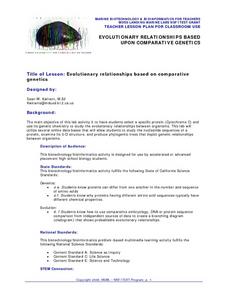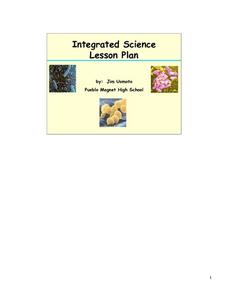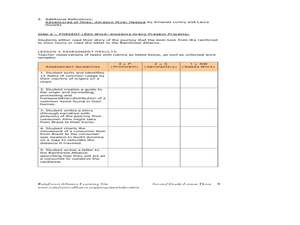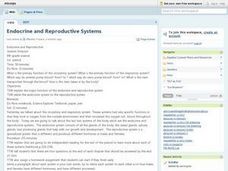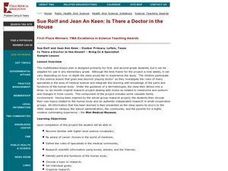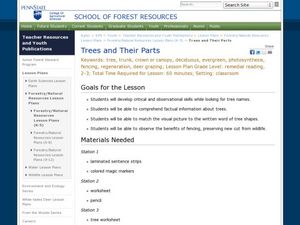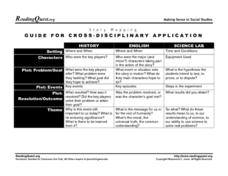Curated OER
Evolutionary Relationships Based Upon Comparative Genetics
High schoolers investigate the protein cytochrome c in an attempt to use its genetic chemistry to study possible evolutionary relationships between organisms. The lesson integrates technology with the use computers to perform DNA analysis.
Curated OER
Who is the Sea Otter Related to?
Students examine the genetic relationships of different organisms. In groups, they discover the importance of genes and how different amino acids show various evolutionary relationships. They use an online database to continue their...
Curated OER
Alcoholic Fermentation in Yeast
Biology learners investigate the effect of sucrose concentration on yeast alcoholic fermentation. During the lesson plan,they compare and contrast the processes of cellular respiration and alcoholic fermentation. They design an...
Curated OER
temperature and the Scientific Method Lesson Plan
Sixth graders study heat, temperature, and heat transfer. Using probeware, the teacher demonstrates boiling points. Students participate in experiments and record the beginning and ending temperatures and mass of objects. After...
Curated OER
Visit To the Farm
Students research farm animals and write a story based on the research.
Curated OER
Look At Those Leaves!
Students collect, measure and classify leaves. In this inquiry-based sorting and classifying lesson, students look at various types of leaves they have collected and measure them using a standard unit of measurement. Next, they relate...
Curated OER
Let's Dig Deeper!
Young scholars investigate rocks and how they are formed and the uses man has for rocks. The topic is narrowed, researched, and documented by three sources. The results are presented to classmates for evaluation.
Curated OER
Scientific Method Unit: Bacteria
Students discover how to apply the steps of the inquiry process through the study of bacteria. Working in groups of four, they cooperatively read an article about bacteria and complete a graphic organizer. Group members share with others...
Curated OER
Products from the Rainforest
Second graders write a story about the journey a food has from the rainforest to your table. For this food lesson plan, 2nd graders research different foods and products that come from the rainforest and discover how it ended up in their...
Curated OER
Endocrine And Reproductive Systems
Learners investigate the hormonal levels that are created with the endocrine system and tie it to the act of sexual reproduction. The lesson plan discusses how the respiratory system is organized as a comparison to the endocrine system...
Curated OER
Is There a Doctor in the House
Sixth graders predict outcomes of research. They analyze data and construct a class graph, then work cooperatively in a small group setting. They explain the prevention aspect of medicine, document references, and continue ongoing...
Alabama Learning Exchange
A Study of Plants
Pupils study and become familiar with parts of a plant by using multi-media resources. They publish a story about plants using a word processing program and include new plant vocabulary that they have learned.
Curated OER
Genetics and Hypermedia
Students use HyperCard and HyperStudio because it allows them to become more creative. They are exploring a new and different studying style and independence in their analysis and reporting of data. This is a great outlet for students...
Curated OER
Research and Report
Students research topics from their social studies or science curriculum. Working in groups, they use the writing process to communicate what they discovered from Internet resources. Research is then presented using PowerPoint,...
Curated OER
Trees and Their Parts
Students research trees and their parts. In this forestry lesson, students participate in various learning stations to identify trees by matching the photographs of the tree to the correct name.
Curated OER
Search and Draw
Students research the answer to two science related questions. Using electronic and traditional sources, student research topics related to a science instructional activity. Answers to the questions are presented through drawings that...
Curated OER
Water Cycle
Third graders explore the water cycle and place pictures of the water cycle in sequential order. They investigate a problem and determine if it is reasonable or not to believe that there is water in air to cause a puddle. ...
Curated OER
Soil Layers
Ninth graders identify the different layers of soil. In this earth science lesson, 9th graders explain how limestone layers are formed. They identify the different parts of the coral colony.
Curated OER
Trees and Their Parts
Students visit five learning stations to explore various aspects of trees. They look for tree names, match visual pictures to the written words of tree shapes, and observe the benefits of fencing and preserving new cut from wildlife.
Curated OER
Living Organisms
First graders investigate living things that are part of a class aquarium. They make observations and answer guided questions about each organism. Students read a Science textbook and engage in a class discussion about the content. Then...
Curated OER
Bat Facts
Student's demonstrate an understanding of basic facts about bats by creating a picture representation of bats in their habitat describing information they learned. The lesson is especially favorable for visual learners.
Curated OER
Stars and the Sun
Sixth graders research and state the differences between different stars and the sun. They tie the magnificence of space with the science fiction novel, "I Robot." Several worksheets and discussions are also covered within this lesson.
Curated OER
Story Mapping: Guide for Cross-Disciplinary Application
In this story mapping worksheet, students read how story mapping can apply to 3 different areas of study: history, English and science lab. The components of story mapping that are included here are setting, characters, problem/goal,...
Curated OER
Oceanography Class Quilt
Students create and observe a collage of oceanography topics that be placed on quilt tiles in a culmination art project to represent information learned.
